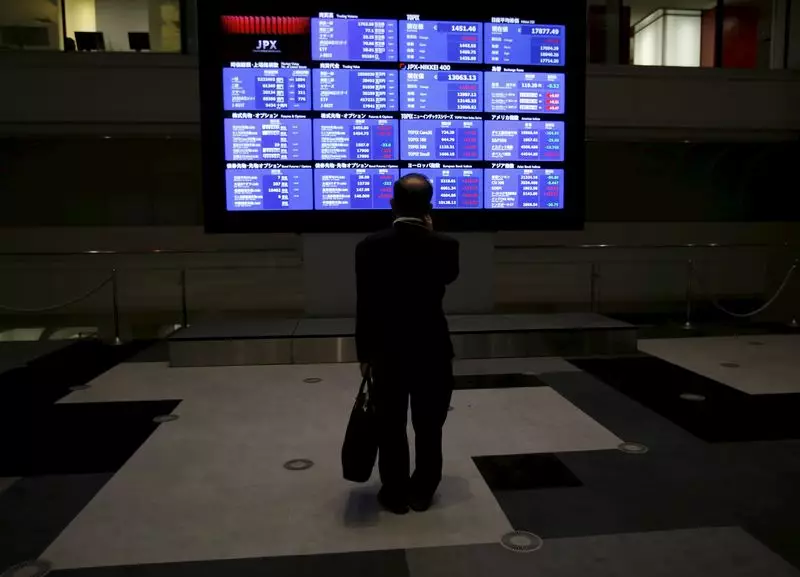In the ever-evolving landscape of global finance, the Asian stock markets have exhibited a cautious stance as holiday trading thins the activity. Investors find themselves grappling with uncertainty, particularly regarding the anticipated economic stimulus measures from the Chinese government. The backdrop of this market watchfulness stems from recent promises of heightened fiscal support, though the lack of specific details has left many questioning the potential impact on the market’s trajectory.
The government of China has created an atmosphere of both optimism and apprehension within the financial community. Minister of Finance Lan Foan’s announcement to “significantly increase” government debt was intended to reassure investors; however, the ambiguity surrounding the total size of the stimulus package has sparked a wave of skepticism. With Chinese stocks previously rallying in response to the government’s aggressive stimulus strategy last month—the most vigorous since the pandemic—the market’s recent pause has raised concerns about its sustainability.
This uncertainty is echoed by market experts like Ray Attrill, the head of FX strategy at National Australia Bank, who highlights the risk of disappointment looming over investor sentiment. The market had anticipated clarity following a briefing on fiscal stimulus measures, but the absence of concrete details has heightened anxiety. As a result, many traders are left contemplating the implications of this tepid response on market performance as they prepare for trading at the start of the week.
The immediate response in Asian markets has been tepid. The MSCI index for Asia-Pacific shares—excluding Japan—saw a marginal increase of just 0.12% after experiencing a decline of 1.7% the previous week. Notably, trading volumes have been significantly lowered due to holidays in countries like Japan, further contributing to the market’s subdued state. In parallel, U.S. stock futures reflect a downward trend, with the S&P 500 and Nasdaq futures seeing slight falls. The lingering volatility serves as a reminder that economic instabilities, particularly in major economies like China, have far-reaching effects on investor behavior around the globe.
Further casting shadows on China’s growth trajectory, recent consumer inflation reports have revealed a surprising decrease, while producer prices have demonstrated signs of deflation. This unfolding data underscores the pressing need for effective stimulus measures, amid growing fears regarding consumer demand, and amplifies the scrutiny over Beijing’s economic management strategies. These dynamics have influenced the offshore yuan, which experienced a 0.2% dip against the dollar, reflecting overall trader disenchantment.
Despite the current uncertainties, some optimistic signs have emerged. Goldman Sachs responded to the recent promises of fiscal stimulus by upgrading its real GDP growth forecast for China to 4.9%, suggesting that while the immediate market response might be hesitant, long-term projections might still reflect a recovery trajectory. However, analysts remain cautious, emphasizing that the fundamental challenges plaguing China’s economy—such as demographic issues, extensive debt management, and supply chain vulnerabilities—are likely to hinder any significant recovery.
As we approach the forthcoming third-quarter GDP release, the balanced interplay between these growth forecasts and the present realities has positioned China’s economy in a precarious state, challenging the government’s efforts to stabilize financial markets while tackling underlying structural issues.
The broader implications for global markets extend beyond Asia. The U.S. dollar continues to maintain its strength as traders scale back expectations of a significant interest rate cut from the Federal Reserve. Currency fluctuations have been moderate, as sterling and the euro exhibit minor declines. The cautious sentiment highlights how interconnected these markets remain, with developments in one region rippling through others.
In the commodities sector, oil prices have also taken a hit in light of the uncertain demand outlook. Prices plummeted by more than a dollar per barrel, indicating that traders are reacting defensively to both inflation data and ambiguous fiscal plans emanating from China. Brent crude and West Texas Intermediate futures have both registered declines, further illustrating how investor sentiment is increasingly sensitive to shifting economic conditions globally.
As Asian investors navigate these turbulent waters, the interplay of anticipation and disappointment remains a critical theme. The broader economic landscape continues to shape market behaviors, demanding a keen eye on geopolitical developments and strategic fiscal policies from major economies like China. While optimistic projections can offer some hope, the prevailing challenges highlight the need for clarity and decisiveness in policy responses to build a more robust path forward in a volatile marketplace.

